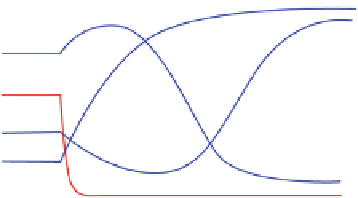Biology Reference
In-Depth Information
a
b
Fig. 13.3 Dynamical models of metabolism. While FBA (Fig.
13.2
) can predict metabolite
concentrations at steady state, i.e., the long-term behavior of a system in a constant environment,
many important biological phenomena involve the transition between growth conditions. Only
dynamical models can represent the system behavior in these situations. (a) In addition to the
metabolic network (
bottom plane in the figure
), such models incorporate varying enzyme
concentrations (
second plane
) and the regulation of gene expression by transcription factors or
other mechanisms of signal transduction (
top plane
). The different levels of regulation have been
separated here for better visualization, but all mechanisms are intertwined in the cell. For example,
certain metabolites (such as cAMP) affect gene expression by modulating the activity of transcrip-
tion factors (
arrows from the bottom plane to the top plane
). These models are formulated as a
system of differential equations, one equation per system component. (b) The simulation of such a
model predicts the time-varying concentration of each system component. Starting from a system
at steady state (and therefore constant concentration of all components), an external parameter
(e.g., the carbon source available in the growth medium) is varied at a specific time (indicated by
the
dashed vertical line
). The rate of change of proteins (transcription factors and enzymes) is slow
(represented by
blue lines
in the figure), whereas the rate of change of metabolite concentrations
can be very rapid (
red line
)
This mode of “environmental detection” allows autonomous metabolic adaptation
to changing environmental conditions, and has important implications for the
construction and functioning of modified or artificial metabolic networks.
These large models of central catabolic pathways in
E. coli
represent probably
the current limit of the pure differential equation-based approach to modeling the








Search WWH ::

Custom Search